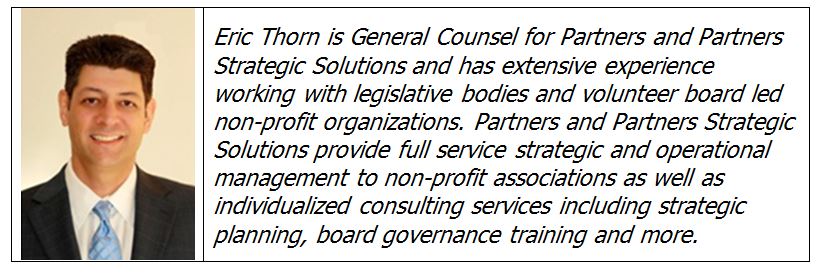By: Eric Thorn, Esq.
Each new year brings many new things. And since many non-profit organizations have calendar year based terms for their officers, a new board chair or president is often one of them. Frequently this is their first time leading a meeting in a more formal manner.
The following are six tips to help your new president or board chair start off the new year on the right foot:
- Agendas in advance – Make sure board members are provided with agendas far enough in advance of the meeting so that they have time to prepare for discussion of the agenda items and will not be surprised. A good rule of thumb is to send these out 30 days in advance. We also recommend sending the board packet with all materials at least one week ahead of the meeting.
- Arrive early – Get to the meeting early so that you have some time to speak with your executive director or board members who may have questions about specific agenda items or issues that they would like to raise that may not be on the agenda. This will give you an opportunity before the meeting to consider how and when to deal with an item, or if it is something that is best included on a future meeting agenda. This can be a great time saver and will help keep the meeting on track.
- Consensus items “without objection” – Voting is for the important stuff. Yet many of us have probably been to a meeting where a board vote is required on a consensus item such as approving the minutes or receiving a report, and even after it is clear there are no changes or objections the chair calls for the vote, “all in favor of approving the minutes . . ., all opposed. . . .” This is usually met with an awkward silence or just a person or two weakly responding. There is a much more graceful way to move things along and avoid the apathetic mood this creates right at the beginning of the meeting. After an opportunity for questions or corrections, and once it is clear that there are none, you can simply state, “Without objection, show the minutes approved.” Another example, after the presentation of a committee report that the board is required to receive, you can say “Without objection, show the committee report received.” This will avoid creating an apathetic atmosphere at the outset and will allow your group to get to the meat of the agenda more quickly.

- Follow the agenda – It is not always possible to anticipate the exact amount of discussion each agenda item will require. In many groups when a robust discussion gets going it is easy for the discussion to veer off into subjects that may be worthwhile but that are not on the meeting agenda. Yet, in order to keep the meeting on schedule and to ensure there is enough time for the board to take action on critical items, it is necessary for the discussion to follow the agenda. One of the most important roles of an effective chair is to direct the group’s conversation back to the agenda item at hand.
- Restate motions clearly – When a matter is being discussed a member of the group may propose a solution in a conversational style and the group may want to vote on it. As chair, it is important that you re-state the motion clearly to help everyone understand exactly what they are voting on. After the chair states the motion, if another person suggests a different solution the chair must remind the group they can only deal with one motion at a time and that the first motion must be withdrawn or voted on before shifting the discussion to the second motion. After any vote is taken, you should state the outcome for the group. “The motion is (or, is not) adopted” Depending on the size and formality of your meetings you may wish to refer to some of the great procedural resources freely available to you such as a procedural motions summary chart.
- Well timed breaks – Well timed breaks are very important for any group. Not only are they important for human comfort at certain intervals, such as water and bathroom breaks, they are also useful if there has been a particularly tense or complex issue that has been discussed for a length of time. A well-timed break will allow board members a short opportunity to stretch their legs, refresh themselves and come back ready to tackle the rest of the agenda.





